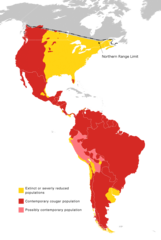Puma
| Puma[1] | |||
| Jardine, 1834[2] | |||
 Przedstawiciel rodzaju – puma płowa (P. concolor) | |||
| Systematyka | |||
| Domena | |||
|---|---|---|---|
| Królestwo | |||
| Typ | |||
| Podtyp | |||
| Gromada | |||
| Podgromada | |||
| Infragromada | |||
| Rząd | |||
| Podrząd | |||
| Infrarząd | |||
| Rodzina | |||
| Podrodzina | |||
| Rodzaj | puma | ||
| Typ nomenklatoryczny | |||
Felis concolor Linnaeus, 1771 | |||
| Synonimy | |||
| |||
| Gatunki | |||
| |||
| Zasięg występowania | |||
 | |||
Puma[4] (Puma) – rodzaj drapieżnego ssaka z podrodziny kotów (Felinae) w rodzinie kotowatych (Felidae).
Zasięg występowania
Rodzaj obejmuje jeden żyjący współcześnie gatunek występujący w Ameryce[5][6][7].
Morfologia
Długość ciała (bez ogona) 86–155 cm, długość ogona 60–97 cm; masa ciała samic 34–48 kg, samców 53–72 kg (wyjątkowo do 120 kg)[6].
Systematyka
Etymologia
- Puma: peruwiańska nazwa (język keczua) Puma dla tego kota[8].
- Viretailurus: Jean Viret (1894–1970), francuski paleontolog; gr. αιλουρος ailouros „kot”[3]. Gatunek typowy: †Panthera schaubi Viret, 1954 (= †Felis pardoides Owen, 1846).
Podział systematyczny
Do rodzaju należy jeden występujący współcześnie gatunek[5][4]:
- Puma concolor (Linnaeus, 1771) – puma płowa
- Puma lacustris Gazin, 1933
- Puma pardoides Owen, 1846
Przypisy
- ↑ Puma, [w:] Integrated Taxonomic Information System [online] (ang.).
- ↑ W. Jardine: The naturalist’s library. Cz. 16: Natural history of the Felinae. Edynburg: W. H. Lizars, 1834, s. 266. (ang.).
- ↑ a b H. Hemmer. Studien an «Panthera» schaubi Viret aua dem Villafranchien von Saint-Vallier (Drôme). „Neues Jahrbuch für Geologie und Paläontologie. Abhandlungen”. 122 (3), s. 324–336, 1965. (niem.).
- ↑ a b W. Cichocki, A. Ważna, J. Cichocki, E. Rajska-Jurgiel, A. Jasiński & W. Bogdanowicz: Polskie nazewnictwo ssaków świata. Warszawa: Muzeum i Instytut Zoologii PAN, 2015, s. 137. ISBN 978-83-88147-15-9. (pol. • ang.).
- ↑ a b C.J. Burgin, D.E. Wilson, R.A. Mittermeier, A.B. Rylands, T.E. Lacher & W. Sechrest: Illustrated Checklist of the Mammals of the World. Cz. 2: Eulipotyphla to Carnivora. Barcelona: Lynx Edicions, 2020, s. 404. ISBN 978-84-16728-35-0. (ang.).
- ↑ a b M.E. Sunquist & F.C. Sunquist: Family Felidae (Cats). W: D.E. Wilson & R.A. Mittermeier (red. red.): Handbook of the Mammals of the World. Cz. 1: Carnivores. Barcelona: Lynx Edicions, 2009, s. 156–157. ISBN 978-84-96553-49-1. (ang.).
- ↑ D.E. Wilson & D.M. Reeder (red. red.): Genus Puma. [w:] Mammal Species of the World. A Taxonomic and Geographic Reference (Wyd. 3) [on-line]. Johns Hopkins University Press, 2005. [dostęp 2021-05-16]. (ang.).
- ↑ T.S. Palmer. Index Generum Mammalium: a List of the Genera and Families of Mammals. „North American Fauna”. 23, s. 598, 1904. (ang.).
- ↑ Puma Jardine 1834 (cougar). Fossliworks. [dostęp 2021-05-15]. (ang.).
- ↑ J.S. Zijlstra: Puma. Hesperomys project. [dostęp 2022-04-06]. (ang.).
Media użyte na tej stronie
Autor: (of code) -xfi-, Licencja: CC BY-SA 3.0
The Wikispecies logo created by Zephram Stark based on a concept design by Jeremykemp.
Autor: Kokosdieb, Licencja: CC BY-SA 3.0
Distribution of Puma concolor as it was known to exist in 2010.
Autor: Luis Miguel Bugallo Sánchez (Lmbuga), Licencja: CC BY-SA 3.0
Puma concolor stanleyana, Rancho Texas Park. Tías, Lanzarote


